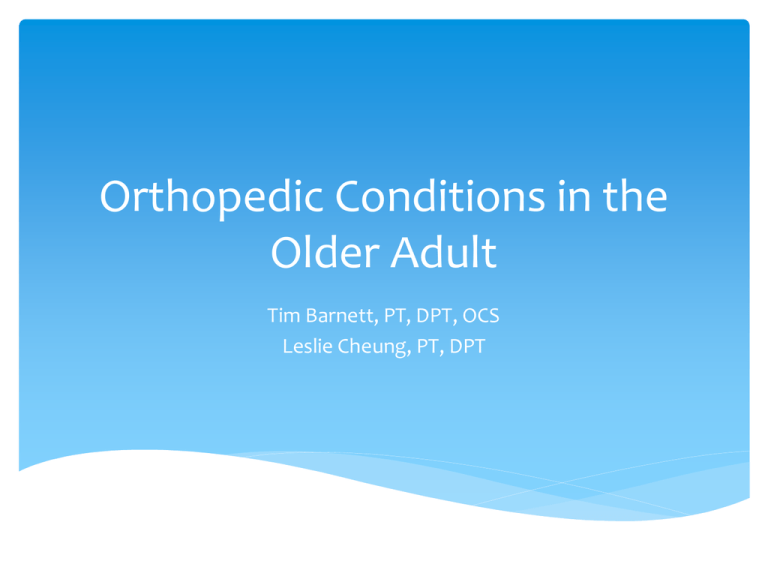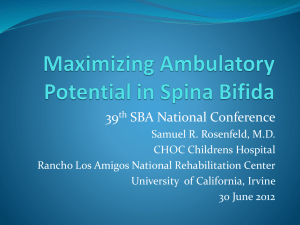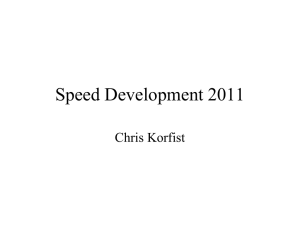405.
advertisement

Orthopedic Conditions in the Older Adult Tim Barnett, PT, DPT, OCS Leslie Cheung, PT, DPT Course Objectives Identify the “older adult” population Discuss… Patient History and Presentation Clinical Prediction Rules Clinical Examination Treatment Outcomes …For Common Orthopedic Conditions Introduction The Older Adult Who are we addressing? (CDC) “The State of Aging and Health in America 2013” How many? Population of 65 and older to double in the next 25 years By 2030 estimated to be 20% of population Health Care: “sick care” or “healthcare” Mobility is critical to health outcomes Orthopedic conditions not in isolation Musculoskeletal health Associated with depression, CV disease, cancer, injuries, and many other conditions Common Orthopedic Conditions Low Back Pain Neck Pain Hip Pain Knee Pain Shoulder Pain Foot and Ankle Conditions Low Back Pain in the Older Adult Common Diagnoses: DDD, stenosis, lumbar strain, sciatica, lumbar radiculopathy, facet joint syndrome History and Presentation Usually gradual onset Maybe central, unilateral, or bilateral May or may not include sciatica Specific questions (“Does this change your symptoms”) Low Back Pain Cluster to rule in/out Malignancy (Henschke, 2007) • • • • Age >50 Hx. CA (+ LR 23.7) Unexplained weight loss Failure of conservative therapy (4 signs present = 100% sensitivity for malignancy) (4 signs absent = -LR 0.00 "confidently rules out malignancy") Low Back Pain Rule in/out Compression Fracture as cause of LBP • Use of corticosteroids (+LR 12) • < 50 years old (+LR 0.26) • > 70 years old (+LR 5.5) • History of trauma Low Back Pain Treatment-Based Classification System Manipulation/Mobilization Stabilization Directional Specific Exercise (flexion more common for this group) Traction Low Back Pain Lumbar Spinal Manipulation CPR (Flynn et al. 2002) • Less than 16 days duration (+LR 4.4) • At least 1 hypomobile segment • At least 1 hip with greater than 35 degrees of motion (+ LR 3.3) • No symptoms distal to the knee • FABQ < 19 points (4 Positive Test: +LR 24) (2 or less Positive Tests: -LR 0.09) Low Back Pain Lumbar Spinal Stabilization CPR (Hicks, McGill et al. 2005) • Age < 40 • SLR > 91 degrees • (+) Prone instability test • Aberrant motions with AROM (3 tests need to be positive for positive inclusion in the clinical prediction rule) (3 Positive Tests: +LR 4.0) Low Back Pain Subjective findings for ruling in relevant Lumbar Spinal Stenosis (Sugioka 2008) • Age >60 years old • Onset of symptoms over 6 months • Decreased symptoms with forward bending • Increased symptoms with backward bending • Increased symptoms in standing • Signs of intermittent claudication • Urinary incontinence Low Back Pain Clinical Examination Gait, Balance (single leg stance) AROM: flexion, extension, lateral flexion, rotation, rotation with extension Hip ROM Dermatomes, Myotomes, DTRs Slump Sitting Straight Leg Raise Palpation Low Back Pain Treatment and Outcomes Rest Ice, heat Medications (pain relievers, muscle relaxants, antiinflammatory) Physical therapy (treatment based classification system) OUTCOMES Oswestry Disability Index (ODI), Global Rating of Change (GROC), pain rating Neck Pain in the Older Adult Common Diagnoses: DDD, cervical sprain/strain, cervical radiculopathy, cervical myelopathy, facet joint syndrome History and Presentation Most often gradual onset (sub-acute or chronic) Local, referred, radicular May include headache Difficulty turning neck (i.e. driving) Aggravating: cervical rotation, prolonged static positions Alleviating: often activity, position change Neck Pain Cervical Radiculopathy Test Item Cluster (Wainner et al. 2003) • Positive distraction test • Less than 60 degress ipsilateral rotation • Positive ULTT (A) • Positive Spurling's test Pre-test probability= 23% (2 Positive Tests: Sensitivity .39, Specificity .56, +LR 0.88, -LR 1.09) (3 Positive Tests: Sensitivity .39, Specificity .94, +LR 6.1, -LR 0.65) (4 Positive Tests: Sensitivity .24, Specificity .99, +LR 30.3, -LR 0.77) Neck Pain Cervical Myelopathy cluster (Cook et al, 2010) Pre-test probability: 35% • Gait deviation • (+) Hoffman test • Inverted supinator sign • (+) Babinski test • Age >45 years (1 (2 (3 (4 of of of of 5 5 5 5 positive positive positive positive tests: tests: tests: tests: +LR +LR +LR +LR 1.4, -LR 0.18) 3.3, -LR 0.63) 30.9, -LR 0.81) infinite, -LR 0.91) Neck Pain Clinical Examination Posture and observation Balance Screen CROM Shoulder Screen: elevation (flexion, abduction, ER hands behind head, IR hands up back) TMJ screen: open/close, protrusion, lateral deviation Vision Cranial Nerve Screen Neck Pain Clinical Examination Ligamentous integrity testing (Sharpe-Purser, transverse ligament, alar ligament) Compression, Distraction, Spurling Upper limb tension testing Clinical Prediction Rule Cervical radiculopathy Cervical myelopathy Neck Pain Treatment and Outcomes Heat, ice, medications, general exercise Physical Therapy Specific exercise and activity Postural and activity modification Manual therapy techniques to the cervical and thoracic spine Traction, modalities OUTCOMES Pain Rating, CROM, NDI, GROC Hip Pain Common Diagnoses: hip OA, DJD, bursitis, fracture History and Presentation Usually gradual onset With trauma (i.e. a fall): rule out hip fracture Often anterior pain with weight-bearing Maybe lateral or posterior-lateral Complaints of pain and stiffness Aggravating: walking, stairs, movement after prolonged static Alleviating: rest, medication Hip Pain CPR for diagnosing Hip OA (Sutlive et al. 2008 JOSPT) • Self report of squatting as an aggravating factor (squat test) • AROM hip flexion causes lateral hip pain • (+) Scour test with adduction causing lateral hip or groin pain • AROM hip extension painful • PROM IR < 25 degrees (1 sign present = +LR 1.2, -LR 0.27) (2 signs present = +LR 2.1, -LR 0.31) (3 signs present = +LR 5.2, -LR 0.33) (4 signs present = +LR 24.3, -LR 0.53) (5 signs present = +LR 7.3, -LR 0.87) Hip Pain Clinical Examination Observation of gait Balance Screen of lumbar spine ROM (flexion and IR most restricted) FABER MMT Timed Up and Go (TUG) Time to rise sit=>stand, walk 3 meters, turn, walk back and sit Hip Pain Treatment and Outcomes Medication Ice, heat Physical Therapy Manual mobilization of the hip and lumbar spine Specific strengthening of the trunk, hips (abductors and extensors), and legs Balance/Proprioceptive training THA OUTCOMES Pain Rating, LEFS, GROC, TUG Knee Pain Common Diagnoses: knee OA, knee DJD, knee sprain/strain, Baker’s cyst, pes anserine bursitis History and Presentation Usually gradual onset Pain most often medial Stiffness, especially upon rising Edema may be evident Aggravating: walking, stairs, squatting, sit<>stand Knee Pain Altman's criteria for Knee OA • (+) Radiographic osteophytosis • Morning stiffness <30 minutes • Crepitus • >50 years old • Tenderness of bony margins of the joint • No palpable warmth of the synovium Knee Pain Ottawa Knee Rules: Radiographs required • Age 55 or older • Tenderness at fibular head • Isolated tenderness at patella • Inability to flex to 90 degrees • Inability to bear weight immediately and in E.R. (4 steps) Knee Pain Clinical Examination Observation of gait Postural Observation (genu varus, valgus) Balance Knee ROM LE MMT Palpation TUG or other functional test Knee Pain Treatment and Outcomes Medication, heat, ice Topicals Bracing (i.e. sleeves, unloading brace) Physical Therapy Mobilization of the lumbar spine, hip, knee, ankle Strengthening: hip abductors and extensors (primary), quads and hamstrings Balance and proprioception enhancement Modalities TKA, debreidment OUTCOMES Pain Rating, LEFS, TUG, ROM Shoulder Pain Common Diagnoses: DJD, RTC tear (full thickness vs partial), tendonitis, sub-acrominal bursitis History and Presentation Sudden or gradual onset (e.g. from falls) Often pain at night Difficulty with dressing, bathing, reaching, driving May have severe weakness Pain may be local only or referred to arm, scapula Shoulder Pain CPR for Subacromial Impingement syndrome (Park et al. 2005) Pre-test probabaility 1.86 Impingment: • (+) Hawkins-Kennedy • Painful Arc Sign • Infraspinatus weakness (All 3 = (+)LR 10.56, (-)LR 0.24) Partial or Full-Thickness tear: • Painful Arc • (+) Drop arm sign • Infraspinatus weakness (All 3 = (+)LR 15.57, (-)LR 0.16) All 3 signs (+) with age > 60 for partial or Full-thickness tear: (+) LR 28 All 3 signs (-) with age > 60 for partial or Full-thickness tear: (-) LR 0.09 Shoulder Pain Criteria for Diagnosis of Adhesive Capsulitis (Zuckerman et al., JSES 2004) • Insidious onet • Night pain • Painful restriction in both active and passive ROM: • Elevation <100 degrees • ER to < half normal to other limb • Normal radiographic appearance Test Cluster for AC joint (Huijbregts 2006) • Active compression test • Cross-body adduction test • AC resisted extension • AC joint tenderness • Paxinos sign (1 positive= +LR 0) (2 positive= +LR 7.4) (3 positive= +LR 8.3) Shoulder Pain Clinical Examination Postural observation Cervical Screen (CROM and Spurling) ROM (general to detailed) MMT (often weakness with ER) Palpation Special Test Drop Arm (r/o RTC tear) Empty Can, Hawkins-Kennedy (impingement, tendonitis) Belly Press, Lift Off (subscapularis) Shoulder Pain Treatment and Outcomes Medications Injections Physical Therapy Manual mobilization of the GHJ, scapula, thoracic spine, and cervical spine Strength and stabilization for scapular mm. and RTC (should not worsen symptoms) Postural education and activity modification Surgical: debriement, RTC repair, TSA, reverse TSA, hemi-arthroplasty Shoulder Pain OUTCOMES Pain rating Shoulder ROM QuickDASH, SPADI Foot and Ankle Conditions Common Diagnoses: DJD, achilles tendonitis, posterior tibial tendonitis, plantar fasciitis History and Presentation Usually gradual onset May complain of joint pain, stiffness, and/or altered sensation Difficulty walking, standing Foot and Ankle Conditions Ottawa Ankle Rules: Radiographs required Ankle: Pain in the malleolar zone + : • Bone tenderness along the distal 6 cm of the posterior edge of the tibia or tip of the medial malleolus • Bone tenderness along the distal 6 cm of the posterior edge of the fibula or tip of the lateral malleolus • An inability to bear weight both immediately and in the emergency room for 4 steps Foot: Pain in the midfoot zone + : • Bone tenderness at the base of the fifth metatarsal • Bone tenderness at the navicular bone • An inability to bear weight both immediately and in the emergency room for 4 steps Foot and Ankle Conditions Clinical Examination Observation of gait Balance Assessment of foot and ankle position Observation of deformities, skin inspection ROM and strength assessment Foot and Ankle Conditions Treatment and Outcomes Medication Orthotics and inserts Physical Therapy Manual mobilization of the foot and ankle Soft tissue mobilization Proprioceptive and strengthening activities OUTCOMES Pain Rating, gait pattern, need for assistive device, LEFS Other Considerations Falls 1 out of 3 adults 65 and older fall each year 20-30% suffer moderate to sever injuries Hip fractures most common Average hospitalization cost $34,294 30 billion in medical cost (2010) Fear of falling may lead to reduced activity Dizziness and Vestibular Dysfunction In the top 3 of most common complaints Positional vs. Velocity dependent vertigo Dizziness Handicap Index Summary Growth of the older population Orthopedic conditions impact quality of life and many other conditions related to health Early identification and intervention Use of Clinical Prediction Rules to assist The healthcare provider-patient interaction as treatment Specific Language Summmary Physical Activity Recommendations 2 hours and 30 minutes of moderate intensity aerobic activity every week with 2 or more days of muscle strengthening activity …or 75 minutes of vigorous intensity aerobic activity every week with 2 or more days of muscle strengthening Orthopedic Conditions in the Older Adult Questions? Thank you!










